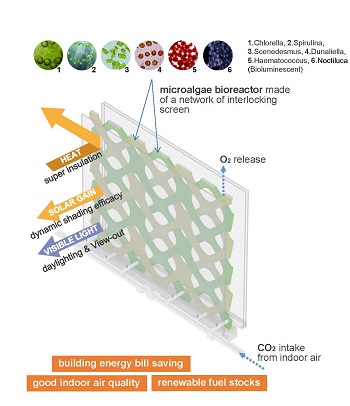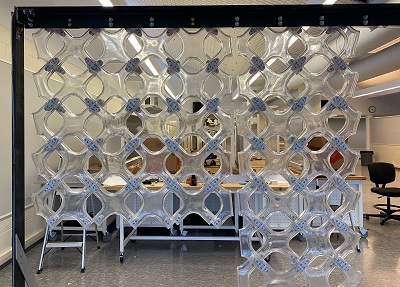
On the second floor of the Storrs Building, home of the School of Architecture, a research project that could revolutionize building enclosures is underway. A team led by Dr. Kyoung Hee Kim, associate professor of architecture and director of the Integrated Design Research Lab, is field-testing a window system that incorporates a network of screens filled with microalgae. Funded by a $225,000 Small Business Technology Transfer Phase I (STTR) grant from the National Science Foundation (NSF), the studies were to have been carried out on a retrofitted 1980s-era school building in Charlotte, but the pandemic disrupted that plan and forced Kim and her team to keep the project at home.
This semester marks a decade since Kim began her microalgae façade research. It was in her first design studio at UNC Charlotte, which was focused on building enclosures, that Kim developed the unusual idea to include microalgae in building façade technology.
“I wanted to make transformative enclosures,” she says, “rather than façades that make incremental advancements.” That was Spring 2011. She wrote and received her first research grant that semester, a $15,000 “People, Planet, Prosperity” award from the Environmental Protection Agency (EPA-P3). Since then she has received two Upjohn Research Initiative grants from the American Institute of Architects and two NSF grants.
 Microalgae is truly a “green” building material. “Algae has very effective carbon sequestration, doesn’t require land to grow, and doesn’t require agricultural water,” Kim says. “It can use salty water or waste water, for example.” The microalgae windows could have multiple environmental benefits, including solar shading and thermal insulation, in addition to carbon sequestration. Not only could that result in lower energy costs and cleaner indoor air, but the algae can also be collected and converted into biofuel, producing a renewable energy source.
Microalgae is truly a “green” building material. “Algae has very effective carbon sequestration, doesn’t require land to grow, and doesn’t require agricultural water,” Kim says. “It can use salty water or waste water, for example.” The microalgae windows could have multiple environmental benefits, including solar shading and thermal insulation, in addition to carbon sequestration. Not only could that result in lower energy costs and cleaner indoor air, but the algae can also be collected and converted into biofuel, producing a renewable energy source.
Kim’s commitment to environmental sustainability initiated during her childhood in Korea, where there was an energy crisis in the 1980s. She grew up in Jeonju, a provincial capital city known for its traditional architecture and culture. Her father was in construction, and her uncle came to the United States to study transportation engineering and infrastructure at Michigan State University. Kim, the oldest of four children, received a Bachelor of Architectural Engineering and a Master of Architectural Engineering from Chungbuk National University in Korea and then decided to follow her uncle’s path to Midwest America. She enrolled at the University of Michigan Ann Arbor and eventually earned two master’s degrees and a PhD in Architecture and began her study of biopolymer and biocomposite façade systems.
While a student at the University of Michigan, Kim met Yaushun Hui, an architecture student from Hong Kong who shared her interest in sustainability. The two married in 2002 and moved to New York City, where Hui practiced as a licensed architect, and Kim became a façade consultant at Front, Inc. They have three sons. In 2019, Kim obtained her architect license and started a practice with her husband, Hui Kim Design & Architecture (HKDNA).
 With her microalgae window prototype in Storrs, Kim will conduct three months of quantitative studies, testing the shading efficacy, the daylighting distribution, and operability of the system. She also hopes to conduct qualitative studies to see whether the system affects human perception and cognitive performance. And she will put together her largest grant application yet: a $1 million award from the NSF to support the next phase of her research.
With her microalgae window prototype in Storrs, Kim will conduct three months of quantitative studies, testing the shading efficacy, the daylighting distribution, and operability of the system. She also hopes to conduct qualitative studies to see whether the system affects human perception and cognitive performance. And she will put together her largest grant application yet: a $1 million award from the NSF to support the next phase of her research.
“I have to be very thorough in preparing to be successful,” she says. “I will do my best!”
